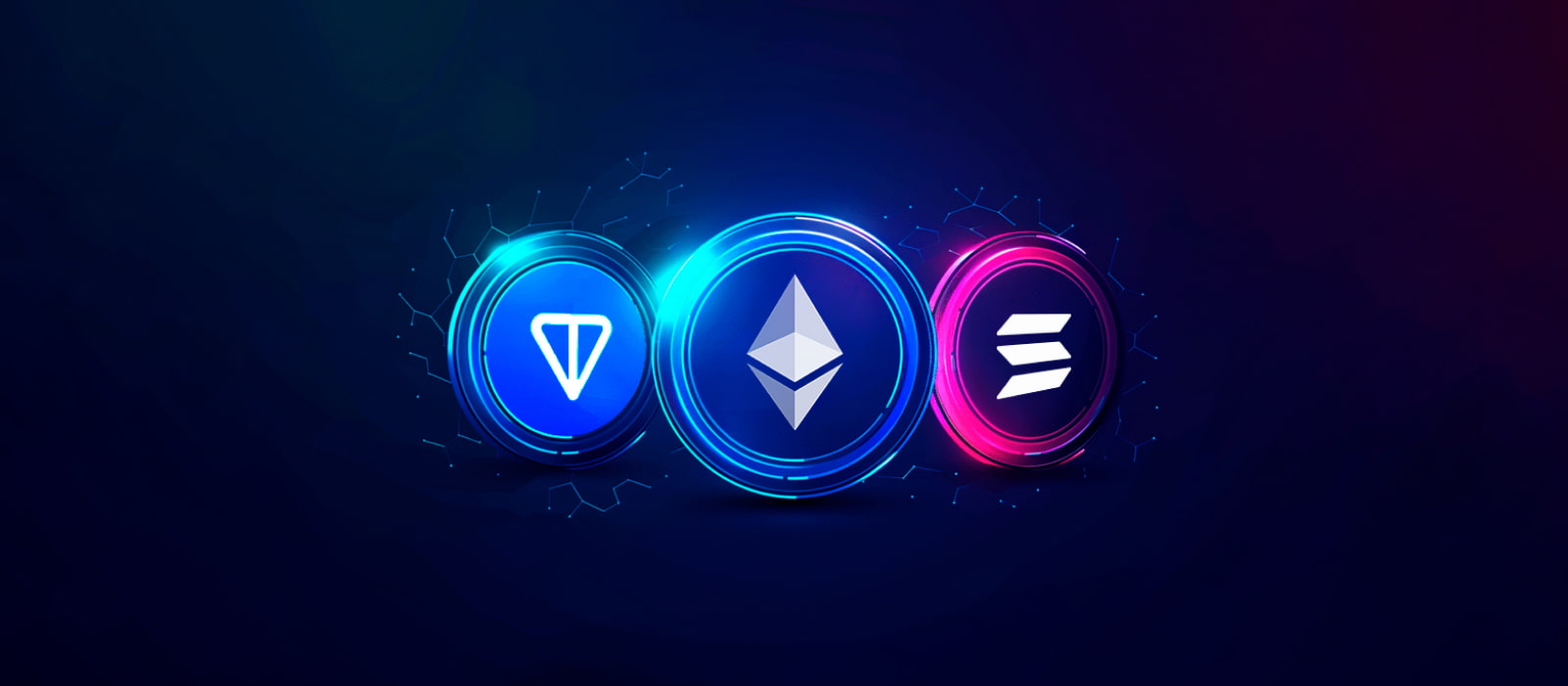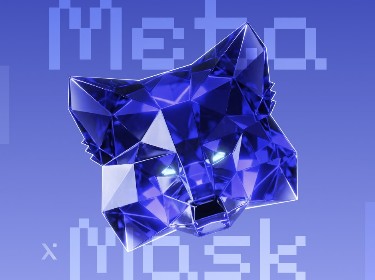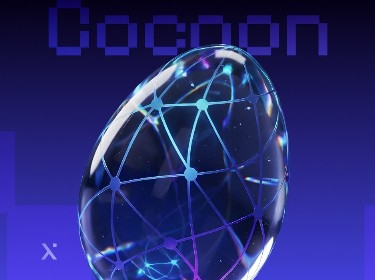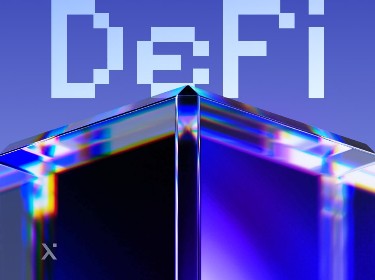Heavyweights like TON, Solana, and Ethereum are all in the running to address key issues in blockchain technology. But the key question is: which platform can bridge the gap between different blockchains, handle a surge in activity, and still be cost-effective?
While innovation and competition drive the vibrant world of blockchain technology, a key challenge persists: scalability and interoperability. Many blockchains struggle to handle increased transaction volume and seamlessly interact with each other.
Let’s delve deeper into how TON, Ethereum, and Solana tackle (or don’t tackle) these crucial aspects. This analysis will help you determine which platform best aligns with your specific needs.
TON vs Ethereum vs Solana: core features
Transaction speed
While Solana boasts a theoretical peak of 65,000 transactions per second (tps), real-world figures settle around 2,000-3,000 tps. This gap reflects network congestion and the time needed for validation. Additionally, Solana prioritizes speed over complete block finalization, which can lead to temporary forks.
On the other hand, TON utilizes sharding to distribute workload across multiple chains. This allows for faster processing, with TON achieving a record of 104,715 tps during a live test. While Ethereum currently struggles with congestion, the switch to PoS during the Ethereum merge was intended to address scalability issues, but challenges with handling a growing number of transactions remain.
Ultimately, the best speed depends on your needs. Solana excels in high-volume, simple transactions, while TON offers immense scalability potential for diverse applications. Ethereum, meanwhile, is working towards a future with faster transaction processing.
![]()
Scalability and sharding
Ethereum suffers from slow transaction processing times. This “bottleneck” hinders user experience and limits the network’s potential. To address this, Ethereum is undergoing a multi-step upgrade process.
The next phase involves sharding, where the network splits into multiple “lanes” to handle more transactions simultaneously. As a stepping stone towards full sharding, Ethereum recently implemented proto-danksharding (EIP-4844) in the Dencun upgrade (March 2024).
This is a data availability layer that reduces storage costs for Layer-2 scaling solutions,which are already processing transactions off-chain to improve scalability. While not a complete solution, proto-danksharding paves the way for further improvements in transaction speed and throughput on the Ethereum network. The next major upgrade, Pectra, is expected in early 2025 and is planned to bring additional optimizations for scalability.
TON takes a different approach. It boasts a dynamic sharding system with “workchains” (232 in total) that can be further subdivided into smaller shards. This flexibility allows for near-instantaneous communication between shards, significantly boosting scalability. Unlike Ethereum’s initial sharding implementation, TON already allows for smart contract execution on its shards.
This enables a powerful feature called Instant Hypercube Routing. Imagine a network of highways where every point can connect to any other point with minimal delay. Instant Hypercube Routing facilitates this by efficiently routing transactions between any shard on the TON network, regardless of their distance. This eliminates bottlenecks and ensures fast and reliable communication across the entire ecosystem.
Solana smart contract development solutions utilize a single blockchain architecture, lacking the sharding capabilities of TON and Ethereum. While currently fast, this design might struggle to handle a surge in transactions as the network grows.
Would you like consultancy on popular blockchains? Contact our blockchain experts to have all your questions answered
Block and finalization time
Ethereum struggles with a relatively slow block time of around 12 seconds. While developers are exploring ways to streamline the process, like “single slot finality” (SSF), this solution is still years away. This delay can be frustrating for users waiting for confirmations, especially for applications requiring real-time transactions.
With TON, blocks are churned out much faster, with a target block time of just 5 seconds. But TON doesn’t stop there. Finalization times are equally impressive, clocking in at under 6 seconds. This rapid processing allows for near-instantaneous confirmations, a game-changer for applications requiring fast settlements.
Solana claims block times of less than 1 second. This raw speed, however, comes with a trade-off. Solana prioritizes speed over immediate finalization, potentially leading to short-lived forks. In the real world, finalizing a block involves validators spread across the globe, requiring several communication rounds. This translates to a finalization time of roughly 6.4 seconds.
Solana’s structure is initially built to optimize for high throughput of basic transactions, like transferring funds. This streamlined design allows them to achieve impressive speeds, particularly attractive for Solana blockchain development focused on high-frequency trading or play-to-earn gaming. However, for complex interactions that involve modifying account data substantially, Solana’s efficiency can be hindered.
![]()
Consensus mechanism
The consensus mechanism is the backbone of many blockchain solutions, ensuring the security and integrity of the network. In this arena, TON vs Ethereum vs Solana present distinct approaches.
Both TON and Ethereum utilize the Proof-of-Stake (PoS) consensus mechanism. In PoS, validators stake their cryptocurrency holdings to secure the network. Validators with larger stakes have a higher chance of being chosen to validate transactions and add new blocks to the blockchain. This approach is known for its energy efficiency compared to the older Proof-of-Work (PoW) mechanism used by Bitcoin and Ethereum before the Merge.
A trusted Solana dApp development company, however, takes a unique path by adopting a hybrid consensus mechanism that integrates Proof-of-History (PoH) with PoS. PoH essentially timestamps transactions before they enter the main consensus process. This innovative approach reduces the time needed for node agreement on transaction order, thus enhancing scalability.
To sum up, PoS offers a secure and energy-efficient way to secure a blockchain. While both TON and Ethereum leverage this approach, Solana’s hybrid PoS with PoH adds another layer of efficiency, potentially paving the way for faster transaction processing.
![]()
Fees
TON and Solana offer significantly lower transaction fees compared to Ethereum. TON’s average fee is around $0.01, while Solana’s is even lower at just $0.005. In contrast, Ethereum’s fees can be much higher, averaging around $20.00 in July 2024.
Ethereum’s high network congestion explains the difference, as it leads to increased gas fees (transaction processing costs).
![]()
Check out our comprehensive overview of the Ethereum Merge
Network performance
While Solana boasts impressive transaction speeds, its network stability has faced challenges. The September 2021 outage, lasting 17 hours due to transaction overload, highlights potential limitations. Further incidents in 2022 and 2024 raise concerns about Solana’s scalability for real-world use.
TON stands out with its superior performance. TON utilizes dynamic sharding, automatically adding new shardchains as network load increases. This enables TON to handle high transaction volumes without sacrificing stability, unlike Solana’s single-chain design.
Due to scalability issues, Ethereum’s performance suffers greatly. To tackle these limitations, such as low transaction throughput and high gas fees, Layer-2 (L2) solutions have emerged. These are secondary protocols built on top of existing blockchain networks, specifically designed to address the main chain’s pressing issues. L2 solutions offer a temporary bridge to improve transaction speed and cost efficiency until Ethereum 2.0’s full deployment promises a more permanent, scalable future.
From dApp consulting to smart contract creation and decentralized application development, our services have you covered
Cross-chain communication
TON stands out for its native support of cross-chain communication. Decentralized bridges operate directly on the TON Blockchain, enabling users to seamlessly transfer assets between TON and other blockchains. This eliminates the need for external solutions and fosters interoperability, allowing dApps to leverage functionalities from various networks.
A key benefit of TON’s native bridges is transaction speed. Studies indicate sub-second transaction times, making TON a strong contender for applications requiring high transaction throughput, such as decentralized exchanges (DeFi) and high-frequency trading platforms.
Unlike TON, Solana lacks built-in cross-chain communication mechanisms. However, the platform fosters interoperability through integrations with various protocols and technologies. One prominent example is Wormhole, a generic messaging protocol that enables seamless movement of assets and data across different blockchains. However, relying on external protocols for cross-chain communication can introduce additional complexity and potential security risks.
Ethereum’s native cross-chain communication capabilities remain limited in 2024. While solutions like wrapped tokens and bridges exist, they can be complex to use and introduce additional fees. These limitations contribute to fragmentation within the DeFi ecosystem, hindering seamless interaction between Ethereum and other blockchains.
Check out our projects based on Layer 2 solutions that boast higher scalability, increased transaction throughput, and reduced gas fees
The developer ecosystem
When it comes to coding, FunC and Fift offer a familiar experience for C/C++ developers working with TON smart contracts, while Tact steps it up with a more robust structure and static cost verification, ideal for complex smart contract development on TON.
Ethereum development leverages Solidity, a high-level language favored for its readability, security features, and suitability for creating smart contracts.
Solana takes a different path with Rust, known for its speed and memory safety claiming Rust’s strengths will empower the high-performance dApps development.
Speaking of resources for developers, Ethereum provides a wealth of mature development kits (SDKs), Integrated Development Environments (IDEs), and comprehensive documentation. TON has made significant strides in 2024 with the introduction of the TON Studio IDE and improved developer guides, making it easier than ever to build on the network. Solana isn’t far behind, actively developing its own suite of developer tools and fostering a rapidly growing community.
Conclusion
In conclusion, the TON vs Ethereum vs Solana debate highlights the diverse needs within the blockchain landscape.
TON development, with its focus on scalability, speed, and seamless cross-chain communication, positions itself as the champion of DeFi solutions. This powerful combination allows for a high volume of transactions at rapid speeds, making TON ideal for applications where efficiency is paramount.
For blockchain development services seeking a mature environment for complex financial applications, Ethereum remains the go-to platform.
Finally, Solana boasts impressive transaction speeds, making it a compelling choice for HFT and play-to-earn gaming where rapid transactions are crucial. However, complex smart contract computations can see a significant slowdown. This can be a disadvantage for applications like complex DeFi protocols or NFT marketplaces that require more processing power.
As these technologies evolve, the battle for dominance will undoubtedly continue, but one thing is certain: the victor will be the blockchain that best caters to the ever-growing needs of its users.




